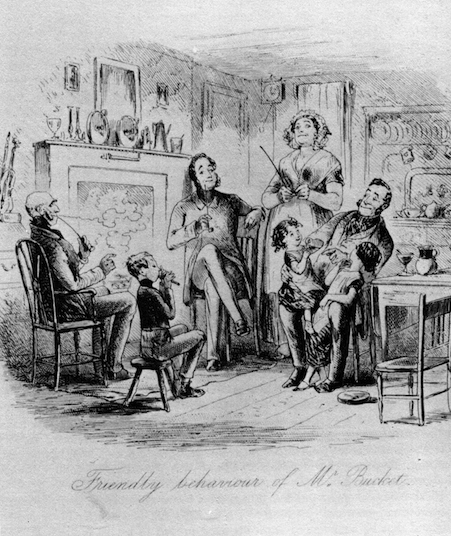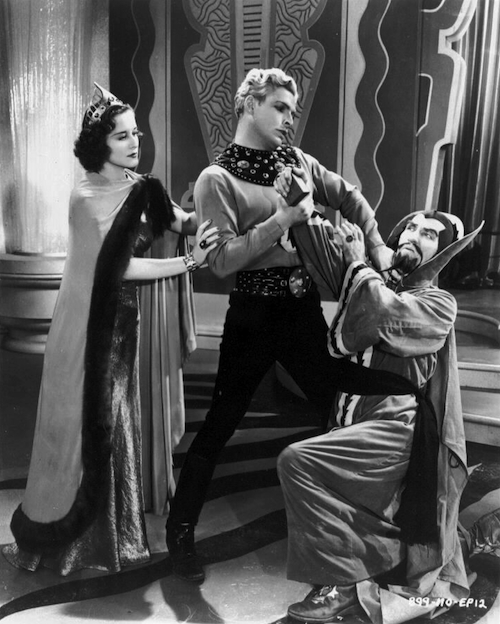 In praise of the delay.
In praise of the delay.
In addition to being an early example of serial fiction, this Halbot K. Brown (“Phiz”) illustration of Inspector Bucket was the first printed picture of a fictional police-detective. It appeared in the first book edition of Bleak House, 1853, by Charles Dickens.
Charles Dickens wrote several of his novels in serialized form initially, including The Pickwick Papers and Oliver Twist. A friend of mine told me that at some point Dickens had to produce 32 pages of set type per month. This meant that Dickens would, pen quill to ink to paper, write out his installments in longhand, and then do his edits—which might mean rewriting some pages or simply crossing out words and passages and writing in new sentences between the lines. He’d take the completed pages to the printer, who no doubt must have made Dickens stay to go over his scribbles, then type on the Linotype (the desk typewriter didn’t come along until after Dickens died) to cast hot metal slugs.
I imagine after an initial period, Mr. Dickens had a rough idea of how many pages of handwritten manuscript he had to produce to meet his quota, but sometimes he was a few pages under or a page or two over. If that was the case, he’d have had to do some fast editing or additions to make the required number as eager readers awaited what next would befall his characters.
The serial in the Victorian era was the soap opera, the Lost, the 24 of its day. Some of Dickens’ and fellow scribes’ installments went on for more than a year in monthly or even weekly installments in the newspapers and magazines of the day. Naturally this helped build sales and circulation for these publications. The writers were paid per word, which certainly encouraged some flowery passages now and then and the need to fill space. Interestingly, the first such serial, albeit in a loose definition of the word, is credited to journalist Edward “Ned” Ward. His nonfiction reportage, The London Spy, which he described as “…a complete survey of the most remarkable places, as well as the common vanities and follies of mankind (both day and night),” was first published in 1698–1700.
The London Spy was a hit and the serial, while birthed in the UK, quickly spread to Paris in the form of Honoré de Balzac and Alexandre Dumas, and later to America with the likes of Mark Twain employing the form. Britisher Charles Reade, whose The Cloister and the Hearth was written in serial form, summed it up best: “Make’em laugh, make ’em cry, make’em wait.” For certainly it’s the serial that perfects the art of the cliffhanger, that last tense scene that suddenly goes to black (the anticlimactic end of The Sopranos being the infuriating exception) and we have to bite our nails until we find out what happened, and what happens next. From the terse scene of Edmond Dantes in The Count of Monte Cristo being hauled away to the dungeons ending with “To be continued” to the radio serials of the last century where the masked villain crept up, gun in hand on the unsuspecting Nick Carter deep in research in his library, and bang, the haunting organ crescendo, and the stentorian announcer saying, “Tune in tomorrow…”—we’re hooked.
In the ’30s, daily adventure comic strips would tailor their storytelling so there would be cliffhangers or some startling information in that last panel to compel us to return to Flash Gordon or The Phantom the following day. Flash, the Ghost Who Walks (the aforementioned Phantom) leapt from the four color pages, along with Blackhawk from DC Comics, the Lone Ranger, Nyoka, a kind of female Tarzan, and many others to the Saturday morning movie serial. These were something like 10-minute episodes of the exploits of these crime fighters you’d experience in chapter installments over a period of 12 or so weeks at your local movie house. This plus maybe two full length flicks as well. Then like their text ancestors, the serials were recut into their own feature-length films or re-cut again as TV came on strong in the ’50s.
 A scene from the 1938 serial Flash Gordon's Trip to Mars (“15 Sensational Sense-Staggering Episodes!”) starring Buster Crabbe as Flash, Beatrice Roberts as Queen Azura, and Charles Middleton as Ming the Merciless.
A scene from the 1938 serial Flash Gordon's Trip to Mars (“15 Sensational Sense-Staggering Episodes!”) starring Buster Crabbe as Flash, Beatrice Roberts as Queen Azura, and Charles Middleton as Ming the Merciless.
Admittedly, compared to Dickens’ Bleak House, the Saturday morning serial, shot for peanuts, wasn’t big on character, emotional depth, or continuity. In our last episode we found our hero tied up in a Packard, a cinder block pressing the accelerator down, and the whole of it rushing into an exploding ball of gas. But come back next week, and, Rashomon-like, that last scene is shown from a different angle (or in some cases reshot entirely with a different sequence of events), with the hero struggling out of his bonds and leaping from the car just in time. No matter, we kids ate it up and laughed and cheered and couldn’t wait to be thrilled again.
Economics and the advent of better special effects in big budget movies helped to kill off the Saturday morning serial. Yet today it seems the Internet has provided for the return of the serial. Not only can you find and listen to old radio shows, but also new stuff like ZBS Productions' MP3 downloads and the new comic strips, a.k.a. web comics, found on sites such as DC’s Zuda—with the mystical Bayou, Projekt Werewolf, and World of Quest, now a cartoon on the Kids WB on Komikwerks—and Big Head’s The Architect and La Muse. Text, too, is very much alive on the web, from Stephen King’s The Green Mile, which was first a serial, to fourstory.org, where mystery novelist Nathan Walpow is serializing a Joe Portugal story, Bad Developments. (Full disclosure: Nathan is also the editor of the fourstory site, and The Underbelly, my serialized mystery, ran on the site last year.)
Our appetite to be thrilled, to be left wanting until that next chapter, still has a hold on us even in this age of instant gratification. I suppose a psychiatrist might make some analogy to the sex drive and the need for stories—anticipation being stronger than fulfillment, but let’s leave that to the eggheads and bow-tied academics to figure out. Right now I’ve got a new installment to grind out.
Gary Phillips writes fictional stories of chicanery and malfeasance in various formats, often drawing on his past experiences. He is a Los Angeles native, and was born and raised in the then South Central area of the city.
This article first appeared in Mystery Scene Summer Issue #105.


